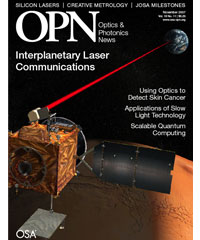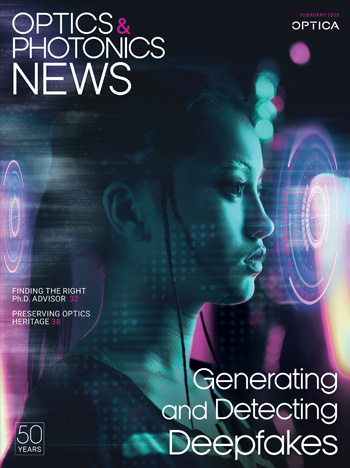
November 2007 Issue
Feature Articles
Interplanetary Laser Communications
Lasers could enable deep-space communication between Earth and planets at the farthest reaches of our solar system. Over the next two decades, optical communications technology is expected to deliver at least an order-of-magnitude higher data rate than conventional radio frequency systems from deep space.
by Hamid HemmatiUsing Optics to Detect Skin Cancer
New techniques in confocal microscopy could make it easier for dermatologists to distinguish between a benign skin spot and one that can kill.
by Patricia DaukantasScalable Quantum Computing with Linear Optics and Quantum Memories
Quantum computing is a powerful application of the laws of quantum physics. It may one day be far more efficient than conventional computation methods at factoring large integers, performing database searches and making quantum physics simulations.
by Zhen-Sheng Yuan, Yu-Ao Chen, Shuai Chen and Jian-Wei PanToward Applications of Slow Light Technology
Scientists working for the Defense Advanced Research Projects Agency (DARPA) are making progress toward the development of robust, integrated devices that can slow, store and process light pulses. Their research will have a far-reaching impact on high-speed optical processing, telecommunications networks and quantum information science.
by Enrique Parra and John R. LowellDepartments and Columns
OPN Talks with Herwig Kogelnik
OPN talks with Herwig Kogelnik, lightwave communications pioneer and OFC/NFOEC keynote speaker.
Hands-on Workshop for Computer-Generated Holography
A three-day workshop offered at the University of Arizona’s College of Optical Sciencesteaches participants how to design and make computer-generated holograms and diffractive optical elements using direct-writing maskless technology.
Out-of-the-Box Metrology
The role of creativity is sometimes undervalued in the sciences. But when it comes to problem-solving in metrology, the ability to think beyond normal boundaries is of paramount importance. Countless patents and measurement processes have sprung from late-night inspirations or other flashes of insight.
Lambda Research Corp.: Establishing a Technology Bridge
On the 15th anniversary of Lambda Research Corporation—a privately held optics software company in Massachusetts—its president and CEO reflects on its founding, its funding and its flourishing business.
Explaining Science in the Courtroom
Explaining science in the courtroom.
Magnets Control Photonic Crystals
Researchers at the University of California, Riverside, not only discovered a way to make photonic crystal structures that self-assemble; they also developed a simple method for actively altering the period of the crystals.
Milestone JOSA articles from 1917-1973
When David MacAdam, the editor of JOSA from 1964 to 1975, was asked his opinion about signifi cant OSA events in 1973, he thought fi rst about all the interesting and important papers that had appeared in JOSA over the years. His list of JOSA milestones takes on special signifi cance this year, which marks the 90th anniversary of the journal.
Ultrafast Silicon Lasers Aim at Communications Tasks
Researchers have demonstrated 1,310-nm lasers on a silicon substrate that operate in continuous-wave mode up to high temperatures and 1,550-nm lasers that operate modelocked to produce the ultrashort pulses at high repetition rates that are desirable for communications.
Did You Know?
Using light to freeze supercooled water.
ADVERTISEMENT
ADVERTISEMENT
Also in this Issue
Book Reviews
Chandra S. Vikram, 1950-2007
Chandra S. Vikram was well known for his contributions to speckle metrology, holography, interferometry and optical logic.

![Illustration of a synapse in the brain. [Getty Images]](https://opnmedia.blob.core.windows.net/$web/opn/media/images/articles/2025/0425/departments/202504-cover-web.jpg?ext=.jpg)
![Fiber draped around a hand, demonstrating its flexibility. [Photo by Z. Wang and L. Wei]](https://opnmedia.blob.core.windows.net/$web/opn/media/images/articles/2025/0325/departments/202503-cover-web.jpg?ext=.jpg)
